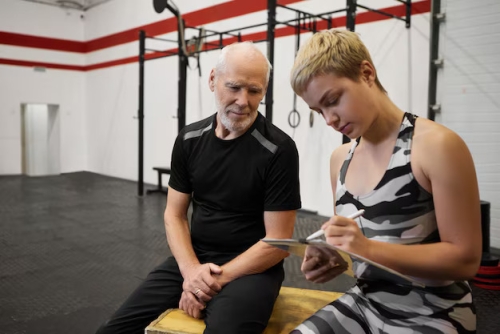As we age, maintaining physical health becomes more important than ever. One of the most beneficial forms of exercise for older adults is strength training. Not only does it help build muscle and increase bone density, but it also enhances balance, mobility, and overall quality of life. Strength training for older adults can be safe and effective when done with proper techniques and precautions.
In this blog, we will discuss the importance of strength training for older adults, the key benefits, tips for getting started, and how to structure safe and effective workouts.
Why Strength Training Matters for Older Adults
Strength training, also known as resistance training, involves using weights, resistance bands, or body weight to strengthen muscles. As we age, our bodies undergo a natural process called sarcopenia, which refers to the gradual loss of muscle mass and strength. This process can begin as early as the age of 30 and accelerates after the age of 60. In addition, bone density tends to decrease with age, increasing the risk of osteoporosis and fractures.
Incorporating strength training into your fitness routine as you age can help combat these age-related changes and provide several benefits for both physical and mental health:
Muscle Mass and Strength: Strength training helps preserve and build muscle mass, which can naturally decline as we age. Having strong muscles not only makes daily activities easier but also improves functional strength, allowing you to perform everyday tasks like carrying groceries, standing up from a chair, or climbing stairs with ease.
Bone Health: Weight-bearing exercises, such as strength training, stimulate bone growth and help prevent bone loss. This is particularly important for reducing the risk of osteoporosis and fractures in older adults.
Joint Health and Mobility: Strength training can improve flexibility, reduce stiffness, and help with joint pain. Strong muscles support the joints, allowing for better range of motion and reduced strain on the ligaments and tendons.
Balance and Fall Prevention: Strength training improves coordination and balance, which are critical for fall prevention. By enhancing muscle strength in key areas, such as the legs and core, older adults can reduce the risk of falls, a leading cause of injury in the elderly.
Mental Health: Regular strength training has been shown to boost mood, reduce symptoms of depression and anxiety, and improve cognitive function. The physical benefits of strength training are often accompanied by improved self-confidence and overall well-being.
Getting Started with Strength Training
Before beginning any new exercise program, especially as an older adult, it's important to consult with your healthcare provider. A doctor can assess your overall health, address any underlying medical conditions, and provide recommendations for a safe exercise regimen tailored to your needs.
Once you've received medical clearance, you can begin strength training with the following guidelines:
Start Slow and Focus on Technique: It's essential to ease into strength training, particularly if you're new to resistance exercises. Start with lighter weights or resistance bands and focus on mastering proper form before gradually increasing the intensity. Good technique will help you avoid injury and maximize the benefits of your workouts.
Warm Up Properly: Warming up prepares your body for exercise by increasing blood flow to the muscles and improving flexibility. Spend 5 to 10 minutes doing light cardio (such as walking or cycling) followed by dynamic stretches before your strength training session.
Use Proper Equipment: If you're using weights, start with dumbbells, kettlebells, or resistance bands that are easy to handle and allow you to perform exercises with good form. If you're working out at home, there are plenty of bodyweight exercises that can be just as effective. Alternatively, gym machines can offer additional support for those who are just starting out.
Work Within Your Limits: Strength training should challenge you, but it should not cause pain. Start with a weight or resistance level that feels manageable and gradually increase the weight as your muscles adapt. Aim for 8-12 repetitions per set, and if you can do more than 12 without feeling fatigued, it’s time to increase the resistance slightly.
Rest and Recovery: Recovery is just as important as the workout itself. Older adults may need more time to recover between strength training sessions. Aim for at least one day of rest between workouts targeting the same muscle group to allow the muscles time to repair and grow stronger.
Safe and Effective Strength Training Exercises for Older Adults
When it comes to strength training for older adults, safety and effectiveness are key. Below are some basic exercises that are beginner-friendly, functional, and highly beneficial for older adults:
1. Chair Squats
Chair squats help build leg strength and improve balance. They also mimic a common functional movement—sitting down and standing up from a chair.
How to Do It: Stand with your feet shoulder-width apart in front of a sturdy chair. Slowly bend your knees and lower your hips, as if you're about to sit in the chair, keeping your chest lifted and knees tracking over your toes. When your hips are just above the seat, press through your heels to stand back up.
Modifications: Use the chair for support if needed. You can add resistance by holding light dumbbells at your sides.
2. Wall Push-Ups
Wall push-ups are a great upper body exercise that builds strength in the arms, chest, and shoulders. They are a safer alternative to floor push-ups for beginners.
How to Do It: Stand facing a wall, about arm’s length away. Place your hands on the wall at shoulder height, slightly wider than shoulder-width apart. Slowly bend your elbows and lower your chest toward the wall, then push back to the starting position.
Modifications: As you build strength, you can gradually move to doing push-ups on a bench or the floor.
3. Seated Row with Resistance Band
A seated row strengthens the back, shoulders, and arms while also improving posture. Using a resistance band adds light resistance without the need for heavy equipment.
How to Do It: Sit on the floor or a chair with your legs extended in front of you. Wrap a resistance band around your feet and hold each end in your hands. Keeping your back straight, pull the band toward your torso, squeezing your shoulder blades together, and then slowly release.
Modifications: Adjust the tension of the band to increase or decrease resistance.
4. Step-Ups
Step-ups are excellent for building strength in the legs, especially the quadriceps and glutes. They also improve balance and coordination.
How to Do It: Stand in front of a step or a sturdy bench. Step up with one foot, followed by the other, so you are standing on the step. Step down one foot at a time to return to the starting position. Alternate the lead foot.
Modifications: Start with a lower step if needed, and use a handrail or chair for support if necessary.
5. Standing Calf Raises
Calf raises strengthen the lower legs and improve balance, which is crucial for fall prevention.
How to Do It: Stand with your feet hip-width apart, holding onto a sturdy surface for balance. Slowly raise your heels off the ground, standing on your toes, then lower back down. Repeat for several repetitions.
Modifications: To increase difficulty, try performing calf raises on a step or adding light weights.
Conclusion
Strength training is a powerful tool for older adults to maintain muscle mass, improve bone density, prevent falls, and enhance overall well-being. With proper guidance, safe techniques, and consistency, strength training can be a rewarding and effective way to stay active and healthy well into your later years. Always start slow, focus on form, and listen to your body. Whether you're new to strength training or a seasoned athlete, it’s never too late to begin—and the benefits are well worth the effort.












 Find Nitrile Gloves Johannesburg Today
Find Nitrile Gloves Johannesburg Today